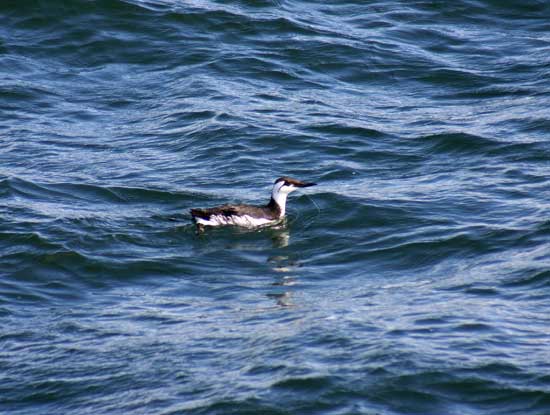- Beginning February 2007, there has been a die-off of Common Murres along the central coast of California.
- The Beach COMBERS program reported 253 newly deposited Murres in the main survey area (11 Monterey Bay beaches encompassing 51km) during the weekly survey window of March 1-7, 2007.
- Depositions of Common Murres on Monterey Bay beaches during 2007 are significantly higher than the 10 year average (1997-2006).
Beginning February 2007, there has been a die-off of Common Murres along the central coast of California. Beach COMBERS, a program that surveys beach cast marine birds and mammals on the beaches of the Monterey Bay National Marine Sanctuary, reported 253 newly deposited murres in the main survey area (11 Monterey Bay beaches encompassing 51km) during the weekly survey window of March 1-7, 2007. This number is 17 times higher than the March survey average of 15 (+/-5 SE) birds in this same survey area since the program began in 1997.
Volunteers from Beach COMBERS, Monterey SPCA, and the International Bird Rescue Research Center (IBRRC) collected birds and submitted them to the Seabird Health Study at the Marine Wildlife Veterinary Care and Research Center in Santa Cruz, CA. Live birds presented weak, dehydrated, and variably exhibited neurologic signs. Post-mortem examinations were performed on 41 Common Murres including 33 juveniles. Findings from gross necropsy revealed that the birds were thin to emaciated and had not eaten recently (empty gastrointestinal tract). This suggests the cause for the die-off was from poor prey availability, which particularly impacted the juvenile age class.
Additional findings included urate stasis which is consistent with dehydration, blood in the gastrointestinal tract which is consistent with stress-induced koilin hemorrhage, visceral pallor which is consistent with anemia from debilitation, and acute blunt trauma which likely was a terminal event associated with debilitation and perhaps adverse weather conditions. None of the adults were reproductively active. There was no evidence of an infectious or toxic insult.
Aerial and ship surveys of seabirds in Monterey Bay conducted in February and March 2007 by the Wind to Whales and the Seabird Population Survey Program of the University of California in Santa Cruz did not record unusual numbers of Common Murres during February and March. The comparison of the abundance of live birds observed at sea and number of beach cast birds further suggests that the high number of beach casts reflect an abnormally higher than usual mortality rate, not an increase of Common Murres in the area.
Interestingly, during this same time die-off of auklets, and to a lesser extent puffins, have been reported in northern California (Marin County and Eureka). Higher than usual numbers of Horned and Tufted Puffins carcasses were also reported by the Fish & Wildlife Service in Newport, Oregon. Oceanographers have been reporting unusual oceanographic conditions off the West Coast of the U.S. over the last couple Spring seasons that resulted in lower productivity and thus probably reducing the amount of prey available to these birds.


Find more pictures of Common Murres in the SIMoN Photo Database.
